2. 成都理工大学地球探测与信息技术教育部重点实验室, 成都 610059;
3. 中国地震局地震预测研究所, 北京 100036
2. Key Lab. of Earth Exploration and Information Technique of Education Ministry of China, Chengdu University of Technology, Chengdu 610059, China;
3. Institute of Earthquake Science, China Earthquake Administration, Beijing 100036, China
2008年5月12日汶川M8.0级大地震发生在青藏高原东缘龙门山断裂带中-北段, 破裂沿中-北段呈北东向单侧扩展[1-3], 龙门山断裂带南段未参与汶川地震的破裂与余震活动[4](见图 1).南段无6.5级以上历史地震记录, 近代仅发生了1941年6月12日宝兴与康定间M6.0、1970年2月24日大邑M6.2两次6级以上地震, 属于长期缺少大震级(M≥7.0)地震事件的破裂空区[4-5].1970年大邑M6.2级地震后, 南段未发生5级以上地震.汶川地震导致周边断层的应力状态发生不同程度的变化, 龙门山断裂带南段库仑破裂应力增强[6-13], 有利于强震的发生.然而, 汶川地震至今, 南段及近邻发生的最大震级地震为2012年10月19日天全—芦山间M4.2(或ML4.6), 震中位于龙门山断裂带南段前陆地带, 南段处于较低水平的地震活动状态.属于长期的大地震空区、近年来地震活动水平偏低的龙门山断裂带南段目前的应力状态及其强震危险性成为重点关注的问题之一.
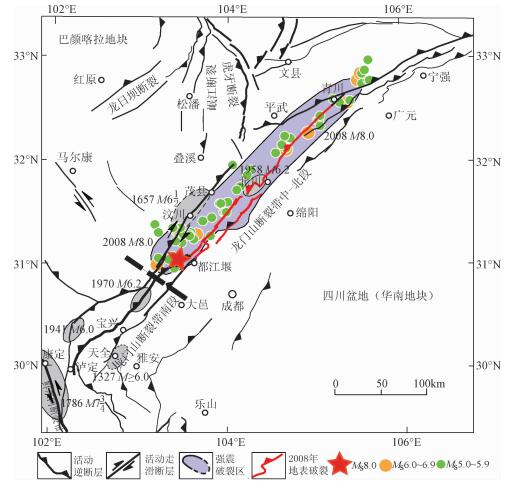
|
图 1 门山及邻区活动构造图[4] 黑色粗虚线以南为龙门山断裂带南段.彩色圆为汶川5级以上余震震中. Fig. 1 Active tectonics for Longmen Shan and its surroundings South of the black thick-dashed line is the southern segment of the Longmen Shan fault zone.Colored circles represent the epicenters of M≥5.0 after shocks of the Wenchuan earthquake. |
强震通常发生于活动断裂带上具有高应力积累的凹凸体[14]或闭锁断裂段[15-16].实验室岩石破裂实验[17]、与流体抽取有关的地震活动研究[18]以及矿山岩石破裂观测[19]等均表明, 应力与古登堡-里克特震级(M)-频度(N)关系式[20]

|
(1) |
中的b值呈反比, b值越低, 应力水平越高.式中a、b为回归常数.b值作为估计断裂带相对应力水平的主要地震活动性参数之一, 已广泛用于中-长期地震危险性评价[15-16, 21-30].近年来, 地震视应力也逐渐用于断裂带应力状态分析与地震趋势判定[31-36].本文利用b值与地震视应力值, 评价龙门山断裂带南段当前应力状态和强震危险性.
2 资料和方法 2.1 b值利用四川区域地震台网1977年1月至2012年12月的地震目录资料计算b值.龙门山断裂带南段位于该台网监测能力相对较高的区域[37].ML≥2.0级地震的震级-频度线性拟合(图 2)相关系数R=0.999, 直线斜率b=1.02±0.007, 与全球范围的区域平均b值一致.因此, 在计算b值时, 取最小完整性震级MC为2.0.图 3给出了1977-2012年龙门山断裂带南段ML≥2.0级地震事件的震中分布, 图中用黑色和绿色区别汶川地震前、后的地震事件.
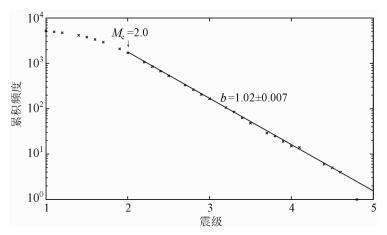
|
图 2 龙门山断裂带南段震级-频度分布图(1977-01-01—2012-12-31) Fig. 2 The frequency-magnitude distribution for the southern segment of Longmen Shan fault zone from Jan.1, 1977 to Dec.31, 2012 |
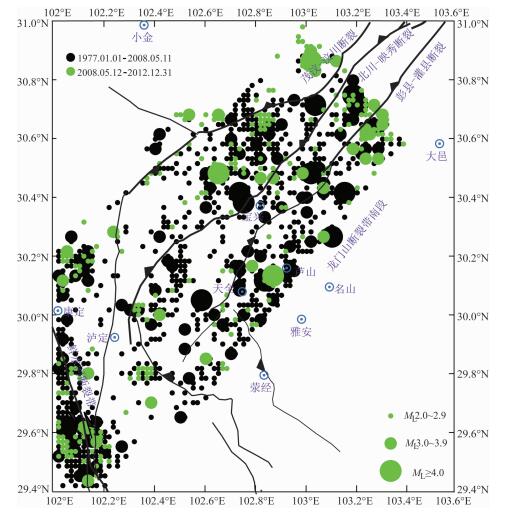
|
图 3 龙门山断裂带南段1977年以来ML≥2.0级地震震中分布 Fig. 3 Distribution of ML≥2.0 earthquakes on the southern segment of Longmen Shan fault zone from Jan.1, 1977 to Dec.31, 2012 |
沿断裂带b值计算方法:沿龙门山断裂带南段, 以0.1°×0.1°间距进行网格化, 挑选出以每个网格节点为圆心、半经为r的圆形统计单元内的地震.确定统计单元内能满足整个研究时段的最小完整性震级MC; 然后, 利用最小二乘法由各单元震级M≥MC的地震资料计算出(1)式中的b值, 将其作为相应单元中心点(即网格节点)的计算值, 进而获得b值空间分布.计算时震级分档间隔取0.1, 每个统计单元内的地震样本数不少于50, 参与拟合的有效震级分档数不低于5档.统计单元的半径r值通常取20 km; 对于地震分布较稀疏的局部区域, 扩大r值, 最大不超过40 km.
2.2 地震视应力地震视应力σapp定义为[38]:

|
(2) |
式中, ES为地震波辐射能量; M0为地震矩; μ为震源区介质剪切模量, 通常取μ=3.0×104 MPa[38-40]. ES与M0之比表示单位地震矩辐射出的地震波能量.地震视应力为震源区绝对应力水平的下限估计[31, 40], σapp值越高, 震源区应力水平越高[31-36].
在近震源情况下, 基于Brune圆盘模型[41], 忽略非弹性衰减, 震源谱可表示为[42]:

|
(3) |
根据地震波形三分向速度记录, 可得合成位移谱:

|
(4) |
在低频段f1-f2, Ω(f)≈Ω0, 则合成位移谱平方的积分SD为:

|
(5) |
获得地震波零频极限Ω0:

|
(6) |
进而求得地震矩M0[42]、考虑低频和高频补偿后的地震波辐射能量ES[43]:

|
(7) |

|
(8) |
式中, f为频率; fc为拐角频率, 求取方法参见相关文献[34]; V(f)为速度谱, 下标Z、NS、EW分别表示垂直、南北、东西向分量; d为震源距; β为S波速, 取β=3.5 km/s; ρ为介质密度, 取ρ=2.71 g/cm3;
Rθφ为辐射图型因子, 取S波的均方根辐射图型因子槡
本文选取四川区域地震台网震中距≤200 km的台站记录的具有较高信噪比的宽频带数字化地震波形资料, 利用S波1.0~20 Hz频带范围的波形计算震源谱, 由(2)式逐台求取地震视应力σapp, 取各台计算结果的平均值作为相应地震的视应力值.为消除个别台站异常高值对结果的影响, 采用Archuleta等[45]的方法求取平均值x珚与标准差Δx:

|
(9) |

|
(10) |
其中, N为计算使用的台站数, xi为第i个台站的计算值.
地震视应力与震级的关系已有不少研究.例如, 李艳娥等先后计算了2007年宁洱M6.4级地震前滇西南地区98次ML≥2.5级地震的视应力、2008年汶川M8.0级地震前四川地区439次ML≥3.0级地震的视应力, 发现:滇西南地区ML2.5~5.0级地震的视应力与震级具有较好的线性关系, 相关系数0.77[34], 四川地区视应力σapp的对数与震级ML呈正比, 相关系数R=0.634[35], 数据离散性高于滇西地区的.王琼等[36]对1999年岫岩M5.4级地震序列的视应力研究结果显示, 视应力与震级关系具有显著的分段性:ML2.0~4.5级地震的视应力与震级具有较好的线性关系, 对于ML≥4.5级地震, 两者非线性相关.上述研究也表明, 地震视应力与震级的相关性存在较显著的地区差异.基于中小地震的视应力具有随震级增大而升高的特征[34-36], 本文在分析比较不同地震的视应力值与区域应力的关系时, 采用如下原则:震级相当时, 视应力值相对高的震源区应力水平高; 视应力值相等时, 震级较低的震源区应力水平高.
3 结果图 4为龙门山断裂带南段b值图像, 除个别统计单元b值标准误差为0.02外, 其余统计单元b值标准误差≤0.01.其中, 图 4a为当前b值分布, 利用1977年1月1日至2012年12月31日ML≥2.0级地震获得.图 4b为Δb值分布图, 是当前b值与利用1977年1月1日至2008年5月11日时段ML≥2.0级地震获得的汶川地震前的b值两者之间的差异, 用于推测大地震后断裂带应力水平的变化.Δb正值表示b值升高, 应力水平下降; 负值则说明b值降低, 应力水平升高.
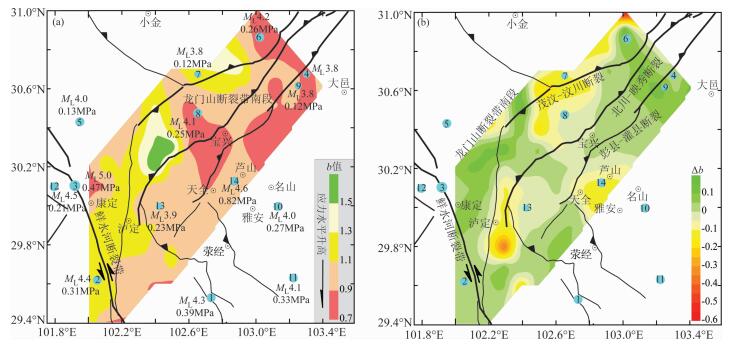
|
图 4 龙门山断裂带南段b值与Δb空间分布 (a)当前b值, 由1977-01-01—2012-12-31时段ML≥2.0资料获得; (b)Δb, 当前b值与1977-01-01—2008-05-11时段b值的差异.蓝色实心圆点代表计算视应力的地震震中, 依据发震时间先后由小到大编号, 震中附近的两行数字分别表示该地震的震级与视应力值 Fig. 4 Maps of b-values and Δb on the southern segment of Longmen Shan fault zone (a)Present b-values from ML≥2.0 earthquakes in the period from Jan.1, 1977, to Dec.31, 2012;(b)Δb values, display variation of present b-values(shown in Fig. 4a)relative to the ones before Wenchuan earthquake from Jan.1, 1977, to May.11, 2008.The blue solid circles are epicenters of the earthquakes for apparents tress calculation, and numbers represent the order for relevant earthquakes according to occurrence time.Magnitudes and values of apparent stress (two lines of data) are also shown near the related epicenters. |
结果表明, 当前龙门山断裂带南段整体平均b值约1.02, 与由1977年1月1日至2008年5月11日资料获得的汶川地震前南段的平均值1.03相近.
龙门山断裂带南段及邻区b值横向差异显著(图 4a).泸定附近、西侧的鲜水河断裂带康定以南段以明显高于区域平均值(1.02)的高b值为特征, 天全北部区域b值高于1.3, 反映龙门山断裂带最西南泸定、天全北部及西侧的鲜水河断裂带康定以南断裂段目前应力水平不高.天全与宝兴之间及宝兴以东, 大部分区域b值 < 0.9, 低于区域平均值, 表明天全—宝兴及其以东目前的应力水平高于最西南的泸定及以西地区.
南段当前b值与汶川地震前b值之间的差异Δb图像(图 4b)显示, 2008年汶川8.0级地震后, 泸定、天全—芦山以及宝兴北部地区b值有较明显降低, 泸定附近区域b值下降尤为突出, 局部b值最大降幅达0.39, 由汶川地震前的1.66下降到目前的1.27, 下降幅度超过23%, 显示该区域在汶川地震后应力水平有明显上升.相反, 靠近汶川地震主破裂区南端的大邑地区、南段西侧的鲜水河断裂带康定以南段b值升高, 应力水平下降.
2007-2012年, 龙门山断裂带南段及近邻区域共发生ML≥3.8级地震14次, 其震中依据发震时间先后由小到大编号绘于图 4中.本文计算了其中13次地震的视应力σapp, 1次事件(图 4中4号地震)因波形重叠未给出计算结果.13次地震的视应力值在0.12~0.82 MPa之间(图 5).为便于与b值结果进行对比分析, 上述地震的震级与视应力值一并标示于图 4a中.
视应力计算结果表明, 汶川地震后, 发生在龙门山断裂带南段的ML≥3.8级地震的视应力水平高于其西侧鲜水河断裂带康定段, 如, 2008年6月26日大邑ML4.2、2009年9月19日宝兴ML4.1级地震的视应力值(图 4a与图 5中6、8号)明显高于2012年3月5日康定ML4.5级地震的视应力值(图 4a与图 5中12号).汶川地震后, 原地应力测量结果显示, 龙门山断裂带南段宝兴测点的水平最大主应力为9.8 MPa, 远高于鲜水河断裂带上康定测点的水平最大主应力2.6 MPa[46], 反映龙门山断裂带南段应力水平高于鲜水河断裂带康定段, 与本文结果相吻合.2012年3月5日康定ML4.5级地震的视应力值(图 4a与图 5中12号)远低于2008年2月16日泸定ML4.4和27日康定ML5.0级地震的视应力值(图 4a与图 5中2、3号), 表明汶川地震后鲜水河断裂带康定以南段应力水平下降.发生在龙门山断裂带南段南侧四川盆地及盆地边缘的2007年7月31日荥经ML4.3、2011年7月25日雅安-名山间ML4.0、10月27日洪雅ML4.1、2012年10月19日天全—芦山间ML4.6级地震的视应力值(图 4a与图 5中1、10、11和14号)均处于拟合趋势线上方, 明显高于龙门山断裂带南段大邑地震的视应力值(图 4a与图 5中6、9号), 说明四川盆地西北部的背景应力水平高于龙门山断裂带南段东端.
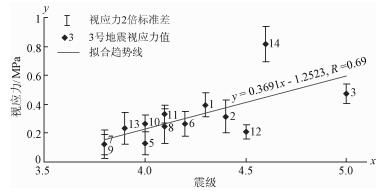
|
图 5 13次ML≥3.8级地震的视应力与震级分布地震序号同图 4. Fig. 5 Distribution of apparent stress values with magnitude for 13 ML≥3.8 events The number of eachearthquake is the same as in Fig. 4. |
静态库仑破裂应力增加0.01 MPa可导致断层破裂[47-48], 使其地震活动产生显著变化.Parsons等[6]计算了汶川地震周边断层的静态库仑应力, 2008年汶川地震加载到龙门山断裂带南段的静态库仑破裂应力值达0.1 MPa; Toda等[7]的研究结果显示, 汶川地震使龙门山断裂带彭-灌断裂南西段的静态库仑破裂应力增加0.419 MPa; 单斌等[9]计算出汶川地震使龙门山断裂带南段库仑破裂应力增加0.005~0.015 MPa, 认为南段存在发生强余震的可能; 万永革等[10]基于GPS和InSAR资料反演的汶川地震破裂模型, 计算出汶川地震加载到龙门山断裂带南段静态库仑破裂应力最大值达0.01 MPa; Xie等[11]的研究结果表明, 汶川地震使北川-映秀断裂和彭县-灌县断裂上的应力明显增加, 前者的应力增加量为0.004~0.045 MPa, 后者为0~0.05 MPa; 华卫等[49]的研究则显示, 宝兴至映秀间库仑应力增加量与多次发生6级强余震的北川至青川段相同, 均达0.05 MPa.上述研究表明, 汶川8.0级地震加载到龙门山断裂带南段的静态库仑破裂应力值已达到甚至远高于静态应力触发阈值0.01 MPa.然而, 与1999年8月17日土耳其伊兹米特Mw7.4级地震触发1999年11月12日迪兹杰Mw7.2级地震[50-51]、2004年12月26日苏门答腊Mw9.2级地震触发2005年3月28日Mw8.7级地震[52]不同, 汶川地震没有在龙门山断裂带南段快速触发出与汶川地震震级相似大小的地震.图 3显示, 汶川地震后, 龙门山断裂带南段地震活动的空间分布特征与汶川地震前基本一致, 表明汶川地震的发生未明显改变南段地震活动的空间格局.可见, 库仑应力增强并非引发强震的决定性因素, 是否发生强震取决于增强区的应力积累水平及是否接近破裂极限.
靠近汶川余震区南端的大邑附近区域b值(图 4a)低于区域平均值, 但未达到异常低值(b < 0.7), 汶川地震后该区域b值升高(图 4b), 应力水平降低, 汶川地震后发生在该区域的两次地震(图 4a与图 5中6和9号)的视应力不高, 反映其长期应力积累水平尚未达到发生强震的应力极限, 这或许是汶川8.0级地震的余震带向南西止于大邑的重要原因之一.该区域仅在2008年6月28日发生了1次ML4.2级地震(图 4a编号6), 之后再无4级地震活动.大邑附近区域的b值升高, 也说明汶川地震后并非整个龙门山断裂带南段都处于应力增强区.
天全—芦山、泸定以及宝兴北部等区域b值降低(图 4b), 应力水平升高, 但整个南段目前没有出现如同2008年汶川8.0级地震前龙门山断裂带中北段那样的异常低b值[4, 27].原地应力测量结果显示, 汶川地震前, 龙门山断裂带北段青川测点的水平最大主应力为21~22 MPa[53], 汶川地震的最大余震即发生在青川, 汶川地震后, 青川测点复测的水平最大主应力值仍高达15~16 MPa[53], 远高于宝兴测点的9.8 MPa[46].因此, 即使龙门山断裂带南段位于汶川地震引起的库仑应力增强区[6-13, 49], 其当前的应力积累水平也不具备发生类似汶川8.0级地震的应力条件, 这可能是汶川地震未能在南段快速触发出相似震级大震的主要原因.赵静等[54]利用1999-2007期GPS水平速度场观测资料反演了汶川地震前龙门山断裂带的闭锁程度, 认为南段闭锁程度低于中-北段.南段短期内不具备发生类似汶川8.0级大震的危险性, 但天全至宝兴段低于区域平均值的b值以及相对较高的地震视应力值(图 4a)反映该断裂段已有一定的应力积累, 具备发生中-强地震的应力条件.
龙门山断裂带南端西侧的鲜水河断裂带康定以南段属于1786年7¾级地震的破裂段[55](图 1).正的Δb表明汶川地震后该段b值升高, 汶川地震后发生在该段的地震的视应力值远低于汶川地震前, 均揭示该段在汶川地震后应力水平下降.该段当前的高b值、低地震视应力值以及相对较低的原地应力测量值[46]反映该断裂段在经历上一次强震破裂后断面尚未耦合, 应力水平较低, 短期内发生强震的可能性较小.
近年发生在龙门山断裂带南段南侧四川盆地西北部的几次ML≥3.8级地震(图 4a与图 5中1、10、11、14号)的视应力值明显偏高, 尤其是2012年10月19日天全—芦山间ML4.6级地震的视应力值异常高(图 4a与图 5中14号), 反映毗邻龙门山断裂带南段的四川盆地区域应力水平相对较高. Parsons等[6]的库仑应力计算结果显示, 2008年汶川地震使位于龙门山断裂带南侧的四川盆地区域应力显著升高, 这或许是汶川地震后四川盆地内4级地震活动水平明显高于汶川地震前的重要原因, 四川盆地具有发生中-强地震的危险性.2013年2月19日在四川盆地历史少震与弱震区三台县发生M4.7级地震, 支持本文的研究结果.
5 结论本文利用1977年1月至2012年12月的地震资料, 通过精细b值空间扫描, 对比汶川地震前、后b值的空间分布差异, 结合中小地震视应力值, 分析了龙门山断裂带南段及附近区域目前的应力状态, 进而分析其强震危险性, 并初步探讨了南段未参与汶川地震破裂与余震活动的原因.
2008年汶川地震后, 龙门山断裂带南段仅部分区域应力增强.天全—芦山、泸定以及宝兴北部等区域b值下降、应力水平明显升高.靠近汶川余震区南端的大邑附近区域b值上升、应力水平下降, 这或许是汶川余震活动止于大邑的重要原因.
龙门山断裂带南段目前整体平均b值约1.02.尽管天全—芦山、泸定、以及宝兴北部等区域在汶川地震后b值下降, 但南段目前仍未出现类似汶川8.0级地震前中-北段那样的异常低b值, 南段整体的当前应力积累水平低于汶川地震前中-北段应力水平, 可能是汶川地震没能在南段快速触发强震的重要原因.短期内南段发生类似汶川8.0级大震的可能性不大, 但天全至宝兴段已具有一定的应力积累, 存在发生中-强地震的危险性.南段西侧的鲜水河断裂带康定以南段应力水平低, 短期内发生强震的可能性较小.
龙门山断裂带南侧四川盆地西北部地区的地震视应力水平明显高于龙门山断裂带南段东端及西侧的鲜水河断裂带康定以南段, 因此, 对四川盆地的中-强地震危险性应引起足够重视.
由于震中距、方位角、台站场地响应、传播路径和震源辐射花瓣效应的差异, 不同台站记录到的地震波形具有较大差异, 使得震源参数的计算存在种种不确定性[56], 导致地震视应力结果存在一定的不确定性.但对于地震活动不活跃、不满足地震活动性参数空间扫描条件的区域, 地震视应力在中、强地震危险区判定中仍可发挥重要作用.
致谢两位审稿专家提出了具有建设性的修改建议.视应力计算得到中国地震局地球物理研究所李艳娥同志的大力帮助.特此致谢!
| [1] | Xu X W, Wen X Z, Yu G H, et al. Coseismic reverse-and oblique-slip surface faulting generated by the 2008 Mw7.9 Wenchuan earthquake, China. Geology , 2009, 37(6): 515-518. DOI:10.1130/G25462A.1 |
| [2] | Zhang P Z, Wen X Z, Shen Z K, et al. Oblique, high-angle, Listric-reverse faulting and associated development of strain: The Wenchuan Earthquake of May 12, 2008, Sichuan, China. Annu. Rev. Earth Planet. Sci. , 2010, 38(1): 353-382. DOI:10.1146/annurev-earth-040809-152602 |
| [3] | 王卫民, 赵连锋, 李娟, 等. 四川汶川8.0级地震震源过程. 地球物理学报 , 2008, 51(5): 1403–1410. Wang W M, Zhao L F, Li J, et al. Rupture process of the Ms8.0 Wenchuan earthquake of Sichuan, China. Chinese J. Geophys. (in Chinese) , 2008, 51(5): 1403-1410. |
| [4] | 易桂喜, 闻学泽, 辛华, 等. 2008年汶川MS8.0地震前龙门山-岷山构造带的地震活动性参数与地震视应力分布. 地球物理学报 , 2011, 54(6): 1490–1500. Yi G X, Wen X Z, Xin H, et al. Distributions of seismicity parameters and seismic apparent stresses on the Longmenshan-Minshan tectonic zone before the 2008 MS8.0 Wenchuan earthquake. Chinese J. Geophys. (in Chinese) , 2011, 54(6): 1490-1500. |
| [5] | 闻学泽, 张培震, 杜方, 等. 2008年汶川8.0级地震发生的历史与现今地震活动背景. 地球物理学报 , 2009, 52(2): 444–454. Wen X Z, Zhang P Z, Du F, et al. The background of historical and modern seismic activities of the occurrence of the 2008 Ms8.0 Wenchuan, Sichuan, earthquake. Chinese J. Geophys. (in Chinese) , 2009, 52(2): 444-454. |
| [6] | Parsons T, Ji C, Kirby E. Stress changes from the 2008 Wenchuan earthquake and increased hazard in the Sichuan basin. Nature , 2008, 454(7023): 509-510. |
| [7] | Toda S, Lin J, Meghraoui M, et al. 12 May 2008 MS7.9 Wenchuan, China, earthquake calculated to increase failure stress and seismicity rate on three major fault systems. Geophys. Res. Lett., 2008, 35: L17305, doi: 10. 1029/2008GL034903. |
| [8] | 邵志刚, 周龙泉, 蒋长胜, 等. 2008年汶川Ms8.0地震对周边断层地震活动的影响. 地球物理学报 , 2010, 53(8): 1784–1795. Shao Z G, Zhou L Q, Jiang C S, et al. The impact of Wenchuan Ms8.0 earthquake on the seismic activity of surrounding faults. Chinese J. Geophys. (in Chinese) , 2010, 53(8): 1784-1795. |
| [9] | 单斌, 熊熊, 郑勇, 等. 2008年5月12日Mw7.9汶川地震导致的周边断层应力变化. 中国科学D辑:地球科学 , 2009, 52(5): 593–601. Shan B, Xiong X, Zheng Y, et al. Stress changes on major faults caused by Mw7.9 Wenchuan earthquake, May 12, 2008. Sci. China Ser. D-Earth Sci. (in Chinese) , 2009, 52(5): 593-601. DOI:10.1007/s11430-009-0060-9 |
| [10] | 万永革, 沈正康, 盛书中, 等. 2008年汶川大地震对周围断层的影响. 地震学报 , 2009, 31(2): 128–139. Wang Y G, Shen Z K, Sheng S Z, et al. The influence of 2008 Wenchuan earthquake on surrounding faults. Acta Seismologica Sinica (in Chinese) , 2009, 31(2): 128-139. |
| [11] | Xie C D, Zhu Y Q, Lei X L, et al. Pattern of stress change and its effect on seismicity rate caused by Ms8.0 Wenchuan earthquake. Sci. China Earth Sci. , 2010, 53(9): 1260-1270. DOI:10.1007/s11430-010-4025-9 |
| [12] | Nalbant S S, McCloskey J. Stress evolution before and after the 2008 Wenchuan, China earthquake. Earth Planet. Sci. Lett. , 2011, 307(1-2): 222-232. DOI:10.1016/j.epsl.2011.04.039 |
| [13] | Zhu H, Wen X Z. Static stress triggering effects related with Ms8.0 Wenchuan earthquake. J. Earth Sci. , 2010, 21(1): 32-41. DOI:10.1007/s12583-010-0001-8 |
| [14] | Aki K. Asperities, barriers, characteristic earthquakes and strong motion prediction. J. Geophys Res. , 1984, 89(B7): 5867-5872. DOI:10.1029/JB089iB07p05867 |
| [15] | Wiemer S, Wyss M. Mapping the frequency-magnitude distribution in asperities: An improved technique to calculate recurrence times?. J. Geophys. Res. , 1997, 102(B7): 15115-15128. DOI:10.1029/97JB00726 |
| [16] | Wyss M, Schorlemmer D, Wiemer S. Mapping asperities by minima of local recurrence time: San Jacinto-Elsinore fault zones. J. Geophys. Res. , 2000, 105(B4): 7829-7844. DOI:10.1029/1999JB900347 |
| [17] | Scholz C H. The frequency-magnitude relation of microfracturing in rock and its relation to earthquakes. Bull. Seism. Soc. Am. , 1968, 58(1): 399-415. |
| [18] | Wyss M. Towards a physical understanding of the earthquake frequency distribution. Geophys. J. Int. , 1973, 31(4): 341-359. DOI:10.1111/j.1365-246X.1973.tb06506.x |
| [19] | Urbancic T I, Trifu C I, Long J M, et al. Space-time correlation of b values with stress release. Pure Appl. Geophys. , 1992, 139(3-4): 449-462. DOI:10.1007/BF00879946 |
| [20] | Gutenberg R, Richter C F. Frequency of earthquakes in California. Bull. Seism. Soc. Am. , 1944, 34(4): 185-188. |
| [21] | Wyss M, Wiemer S. Change in the probability for earthquakes in southern California due to the Landers magnitude 7.3 earthquake. Science , 2000, 290(5495): 1334-1338. DOI:10.1126/science.290.5495.1334 |
| [22] | Zuñiga F R, Wyss M. Most-and least-likely locations of large to great earthquakes along the Pacific coast of Mexico estimated from local recurrence times based on b-values. Bull. Seism. Soc. Am. , 2001, 91(6): 1717-1728. DOI:10.1785/0120000303 |
| [23] | Schorlemmer D, Wiemer S, Wyss M. Variations in earthquake-size distribution across different stress regimes. Nature , 2005, 437(7058): 539-542. DOI:10.1038/nature04094 |
| [24] | Wyss M, Stefansson R. Nucleation points of recent mainshocks in Southern Iceland, mapped by b-values. Bull. Seism. Soc. Am. , 2006, 96(2): 599-608. DOI:10.1785/0120040056 |
| [25] | Ghosh A, Newman A V, Thomas A M, et al. Interface locking along the subduction megathrust from b-value mapping near Nicoya Peninsula, Costa Rica. Geophys. Res. Lett., 2008, 35: L01301, doi: 10. 1029/2007GL031617. |
| [26] | 易桂喜, 闻学泽, 范军, 等. 由地震活动参数分析安宁河-则木河断裂带的现今活动习性及地震危险性. 地震学报 , 2004, 17(3): 322–333. Yi G X, Wen X Z, Fan J, et al. Assessing current faulting behaviors and seismic risk of the Anninghe-Zemuhe fault zone from seismicity parameters. Acta Seismologica Sinica (in Chinese) , 2004, 17(3): 322-333. DOI:10.1007/s11589-004-0054-9 |
| [27] | 易桂喜, 闻学泽, 王思维, 等. 由地震活动参数分析龙门山-岷山断裂带的现今活动习性与强震危险性. 中国地震 , 2006, 22(2): 117–125. Yi G X, Wen X Z, Wang S W, et al. Study on fault sliding behaviors and strong-earthquake risk of the Longmenshan-Minshan fault zones from current seismicity parameters. Earthquake Research in China (in Chinese) , 2006, 22(2): 117-125. |
| [28] | Zhao Y Z, Wu Z L. Mapping the b-values along the Longmenshan fault zone before and after the 12 May 2008, Wenchuan, China, MS8.0 earthquake. Nat. Hazards Earth Syst. Sci. , 2008, 8: 1375-1385. DOI:10.5194/nhess-8-1375-2008 |
| [29] | Working Group of M7. Study on the Mid-to Long-term Potential of Large Earthquakes on the Chinese Continent. Beijing: Seismological Press, 2012 : 336 . |
| [30] | 龙锋, 蒋长胜, 冯建刚, 等. 历史大地震破裂区地震危险性的地震活动性定量分析--以南北地震带中北段为例. 地震 , 2012, 3(3): 98–108. Long F, Jiang C S, Feng J G, et al. Quantitative seismicity analysis for the risk of historical large earthquake rupture zones: applied to the mid-north segment of the South-North Seismic Belt. Earthquake (in Chinese) , 2012, 3(3): 98-108. |
| [31] | 吴忠良, 黄静, 林碧苍. 中国西部地震视应力的空间分布. 地震学报 , 2002, 24(3): 293–301. Wu Z L, Huang J, Lin B C. Distribution of apparent stress in western China. Acta Seismologica Sinica (in Chinese) , 2002, 24(3): 293-301. |
| [32] | 陈学忠, 王小平, 王林瑛, 等. 地震视应力用于震后趋势快速判定的可能性. 国际地震动态 , 2003(7): 1–4. Chen X Z, Wang X P, Wang L Y, et al. Possibility of earlier judgement on seismic tendency after strong earthquakes upon their apparent stresses. Recent Developments in World Seismology (in Chinese) , 2003(7): 1-4. |
| [33] | 乔慧珍, 程万正, 陈学忠. 安宁河-则木河断裂带地震视应力研究. 地震研究 , 2006, 29(2): 125–130. Qiao H Z, Chen W Z, Chen X Z. Study on the apparent stress of the earthquakes on Anninghe-Zemuhe fault. J. Seism. Res. (in Chinese) , 2006, 29(2): 125-130. |
| [34] | 李艳娥, 陈学忠, 付虹. 2007年云南泞洱Ms6.4地震前滇西南地区震源动力学参数时空变化特征. 地震 , 2012, 32(1): 28–39. |
| [35] | 李艳娥, 陈学忠, 王恒信. 汶川8.0级地震前四川地区地震视应力时空变化特征. 地震 , 2012, 32(4): 113–122. Li Y E, Chen X Z, Wang H X. Temporal and spatial variation of apparent stress in Sichuan area before the Ms8.0 Wenchuan earthquake. Earthquake (in Chinese) , 2012, 32(4): 113-122. |
| [36] | 王琼, 陈学忠, 王琳瑛. 岫岩地震序列视应力变化及其预测意义. 地震 , 2005, 25(2): 91–97. Wang Q, Chen X Z, Wang L Y. Change of apparent stress of Xiuyan earthquake sequence and its prediction significance. Earthquake (in Chinese) , 2005, 25(2): 91-97. |
| [37] | 易桂喜, 龙锋, 张致伟. 汶川Ms8.0地震余震震源机制时空分布特征. 地球物理学报 , 2012, 55(4): 1213–1227. Yi G X, Long F, Zhang Z W. Spatial and temporal variation of focal mechanisms for aftershocks of the 2008 Ms8.0 Wenchuan earthquake. Chinese J. Geophys. (in Chinese) , 2012, 55(4): 1213-1227. |
| [38] | Wyss M, Brune J N. Seismic moment, stress, and source dimensions for earthquakes in the California-Nevada region. J. Geophys. Res. , 1968, 73(14): 4681-4694. DOI:10.1029/JB073i014p04681 |
| [39] | Choy G L, Boatwright J L. Global patterns of radiated seismic energy and apparent stress. J. Geophys. Res. , 1995, 100(B9): 18205-18228. DOI:10.1029/95JB01969 |
| [40] | Wu Z L. Scaling of apparent stress from broadband radiated energy catalogue and seismic moment catalogue and its focal mechanism dependence. Earth Planets Space , 2001, 53: 943-948. DOI:10.1186/BF03351691 |
| [41] | Brune J N. Tectonic stress and the spectra of seismic shear waves from earthquakes. J. Geophys. Res. , 1970, 75(26): 4997-5009. DOI:10.1029/JB075i026p04997 |
| [42] | Jiménez A, García J M, Romacho M D. Simultaneous inversion of source parameters and attenuation factor using genetic algorithms. Bull. Seism. Soc. Am. , 2005, 95(4): 1401-1411. DOI:10.1785/0120040116 |
| [43] | Snoke J A. Stable determination of (Brune) stress drops. Bull. Seism. Soc. Am. , 1987, 77(2): 530-538. |
| [44] | Aki K, Richards P G. Quantitative Seismology, Theory and Methods. San Francisco: Freeman & Company, 1980 . |
| [45] | Archuleta R J, Cranswick E, Mueller C, et al. Source parameters of the 1980 Mammoth Lakes, California, earthquakes sequence. J. Geophys. Res. , 1982, 87(B6): 4595-4607. DOI:10.1029/JB087iB06p04595 |
| [46] | 吴满路, 张岳桥, 廖椿庭, 等. 汶川地震后沿龙门山裂断带原地应力测量初步结果. 地质学报 , 2010, 84(9): 1291–1299. Wu M L, Zhang Y Q, Liao C T, et al. Preliminary results of in situ stress measurements along the Longmenshan Fault Zone after the Wenchuan Ms8.0 earthquake. Acta Geologica Sinica (in Chinese) , 2010, 84(9): 1291-1299. |
| [47] | King G C P, Stein R S, Lin J. Static stress changes and the triggering of earthquakes. Bull. Seism. Soc. Am. , 1994, 84(3): 935-953. |
| [48] | Harris R A. Introduction to special section: stress triggers, stress shadows, and implications for seismic hazard. J. Geophys. Res. , 1998, 103(B10): 24347-24358. DOI:10.1029/98JB01576 |
| [49] | 华卫, 陈章立, 李志雄, 等. 汶川8.0级地震触发与余震活动空间分布研究. 地震 , 2009, 29(1): 33–39. Hua W, Chen Z L, Li Z X, et al. Seismic triggering and the aftershock distribution of the Wenchuan M8.0 earthquake. Earthquake (in Chinese) , 2009, 29(1): 33-39. |
| [50] | Utkucu M, Nalbant S S, McCloskey J, et al. Slip distribution and stress changes associated with the 1999 November 12, Düzce (Turkey) earthquake (Mw=71). Geophys. J. Int. , 2003, 153(1): 229-241. DOI:10.1046/j.1365-246X.2003.01904.x |
| [51] | Daniel G, Marsan D, Bouchon M. Perturbation of the Izmit earthquake aftershock decaying activity following the 1999 Mw7.2 Düzce, Turkey, earthquake. J. Geophys. Res., 2006, 111, B05310, doi: 10. 1029/2005JB003978. |
| [52] | Pollitz F F, Banerjee P, Bürgmann R, et al. Stress changes along the Sunda trench following the 26 December 2004 Sumatra-Andaman and 28 March 2005 Nias earthquakes. Geophys. Res. Lett., 2006, 33(6), doi: 10. 1029/2005GL024558. |
| [53] | 郭啟良, 王成虎, 马洪生, 等. 汶川Ms8.0级大震前后的水压致裂原地应力测量. 地球物理学报 , 2009, 52(5): 1395–1401. Guo Q L, Wang C H, Ma H S, et al. In-situ hydro-fracture stress measurement before and after the Wenchuan Ms8.0 earthquake of China. Chinese J. Geophys. (in Chinese) , 2009, 52(5): 1395-1401. |
| [54] | 赵静, 江在森, 武艳强, 等. 汶川地震前龙门山断裂带闭锁程度和滑动亏损分布研究. 地球物理学报 , 2012, 55(9): 2963–2972. Zao J, Jiang Z S, Wu Y Q, et al. Study on fault locking and fault slip deficit of the Longmenshan fault zone before the Wenchuan earthquake. Chinese J. Geophys. (in Chinese) , 2012, 55(9): 2963-2972. |
| [55] | 易桂喜, 范军, 闻学泽. 由现今地震活动分析鲜水河断裂带中-南段活动习性与强震危险地段. 地震 , 2005, 25(1): 58–66. Yi G X, Fan J, Wen X Z. Study on faulting behavior and fault-segments for pot-ential strong earthquake risk along the central-southern segment of Xianshuihe fault zone based on current seismicity. Earthquake (in Chinese) , 2005, 25(1): 58-66. |
| [56] | 杨志高, 张晓东. 紫坪铺水库地区蓄水前后视应力标度率变化研究. 地球物理学报 , 2010, 53(12): 2861–2868. Yang Z G, Zhang X D. The transition of apparent stress scaling law before and after impounding in Zipingpu reservoir region. Chinese J. Geophys. (in Chinese) , 2010, 53(12): 2861-2868. |
 2013, Vol. 56
2013, Vol. 56

